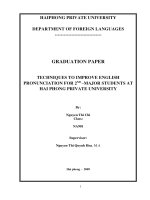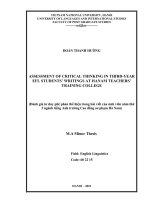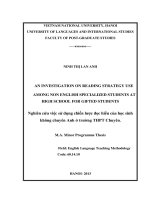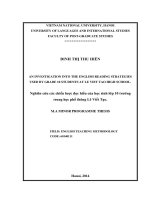An evaluation on the coursebook Lifelines Elementary for non-English major students at Laocai Teachers Training College
Bạn đang xem bản rút gọn của tài liệu. Xem và tải ngay bản đầy đủ của tài liệu tại đây (137.54 KB, 6 trang )
An evaluation on the coursebook Lifelines
Elementary for non-English major students at
Laocai Teachers Training College
Ngô Thị Thu Nga
Trường Đại học Ngoại Ngữ
Luận văn ThS. Chuyên ngành: English Linguistics; Mã số: 60 22 15
Người hướng dẫn: Ph.D. Đỗ Tuấn Minh
Năm bảo vệ: 2010
Keywords: Tiếng Anh; Giáo trình; Sinh viên
Content:
PART I: Introduction
1.1. Rationale and aims of the study
Course books have played an important role in most language programs. However, research has
suggested that despite their important role, course books are not always professionally designed
and do not always fit the curriculum and closely correspond with the objectives of the course and
the needs of the students. Thus, course books should be carefully evaluated and selected before
being used for a language program. On the other hand, course book evaluation does help the
managerial and teaching staff select the most appropriate materials available for a particular
course. It also helps to identify the strengths and weaknesses of a particular course book that is
already in use. This is to inform teachers in the process of course book adaptation and decision-
making for the next courses.
At Laocai Teacher Training College (LTTC), English has been a compulsory subject since 1992.
However, there has not been an official course book which is approved by the Ministry of
Education since then. The teacher there themselves choose the course book that they believe
appropriate to their students without a research. The New Cambridge English course I (Michael
Swan &Catherine Walter, 1990) was chosen to be the course book for 14 years, from 1992 to
2006. Then the teachers there found it no longer suitable because of the out-of-date information
and boring tasks in the book. Again, they themselves chose another course book titled Lifelines
(Elementary) (Tom Hutchinson, Oxford University Press, 2002), which is being used at many
other colleges in some Northern mountainous province in Vietnam. The Lifeline (Elementary)
has been the main course book for all the non-English major students there since 2006. Though,
it has never been evaluated. The author of this study is one of the teachers who have work with
this course book for some years. She wishes to know to what extent the course book suits her
students. So she decided to conduct an official research to evaluate it.
This study seeks to evaluate the course book Lifelines (Elementary) (Tom Hutchinson, Oxford
University Press, 2002) which is in use for the non-English major students at Laocai Teacher
Training College. Specifically, it seeks to examine the suitability of the course book to those
students. That is, it seeks to answer the question “To what extent does the Lifelines
(Elementary) course book suit the non-English major students at Laocai Teacher Training
College?” As this is only a small-sized scale study, a number of issues, though intriguing, would
be beyond the scope of inquiry and would be best dealt with in a further study.
1.2. Significance of the study
This study can be significant in some ways. As discussed earlier, course book is a key
component in most language programs. In the teaching context at Laocai Teacher Training
College, it may even constitute the main source of language input that learners receive and the
basis for language practice that occur both inside and outside the classroom. In order to serve
their purposes most effectively, course books need to be professionally designed, fit the
curriculum and closely correspond with the aims of the teaching program and the needs of the
students. However, after four years of being used, the Lifelines (Elementary) reveals several
problems which bring teachers and students working with it considerable difficulty in meeting
students’ needs and achieving the ultimate goal of their teaching and learning program as well.
The current research helps to identify the problems and suggests some recommendations to
improve them. This contribution would be of practical value to teachers and teacher trainers in
other colleges in some Northern mountainous province in Vietnam whose students and teaching
context are the same as the author’s.
1.3. Research questions
This study aims to answer the question “To what extent does the course book Lifelines
(Elementary) suit the non-English major students at Laocai Teacher Training College?”
In order to answer the research question, the following specific research questions were raised:
1. Is Lifelines (Elementary) appropriate to the students’ level and the objectives of the
course?
2. To what extent does the course book meet the students’ needs?
3. Is the course book suited to current teaching and learning methods?
1.4. Methods of the study
The methods employed in this study included document analysis, student survey, questionnaire,
informal interview, and class observation. For the purpose of course book analysis, an in-depth
evaluation of the Lifelines (Elementary) was conducted using the model of Hutchinson & Waters
(1993). The student survey (Appendix 1) enabled to collect students’ opinions about the
practicality as well as the suitability of the course book. In designing the survey the author used
more closed questions than open-ended ones in order to easily quantify the data. The survey was
written in English and included five sections. The first section gathered general information of
the informants but allowed for anonymity. The second section consisted of three questions
asking the appropriateness of the course book to the objectives of the course. The third section
includes eight questions asking about the suitability of the course book to the students’ needs.
The last two sections which involve 14 questions were designed to find out the teaching and
learning methods, learning conditions, and students’ comments and suggestions. The respondents
of the survey were 275 non-major English students at the college. The data collection took place
during June 2010 at the college. Besides, three telephone interviews with three good former
students were conducted. The purpose of conducting the interview was to get more objective and
exactly results. This information would help to explain the findings in a more objective manner.
Each interview lasted approximately 30 minutes and the author used note-taking techniques to
record the information.
1.5. Design of the study
This study mainly consists of three main parts: Part I begins with a general introduction covering
the reasons for choosing the theme, aims, research questions, research methods, and design of the
study. Part II contains two chapters: Chapter I deals with the literature review in which the most
important notions related to materials evaluation are discussed. Readers are provided with
concise understandings of the approaches, types, and methods of evaluation. Chapter II is
devoted to the analysis of the survey questionnaire of the course book evaluation carried out at
LTTC, in which objectives, description, data collation, and analysis are demonstrated in details.
On the basis of the findings in the previous parts, part III shows some recommendations and
conclusion which encloses practical suggestions for the future use of this course book. An useful
appendix can be found at the end of the thesis.
REFERENCES
1. Brown, J.D (1995), The Element of Language Curriculum, Newbury House Teacher
Development
2. Candlin, C.N. & Breen, M. (1987), ELT Textbooks and Materials: Problems in
Evaluation and Development. ELT document. London, Modern English Publications.
3. Cunningsworth, A. (1995). Choosing your course book. Oxford: Heinemann.
4. Dudlley-Evans, T. & Students.John, M.J. (1998), Development in English for Specific
Purposes: A Multidisciplinary approach, Cambridge: Cambridge University Press
5. Ellis, R. (1997), The Empirical Evaluation of Language Teaching Materials, ELT Journal
6. Foddy, W. (1993), Constructing Questions for Interviews and Questionnaires: Theory
and Practice in social research, Cambridge: Cambridge University Press
7. Gabrielatos, C. (2001), Materials Evaluation and Adaptation: A case Study of Grammar
Teaching. Retrieved in August 15, 2006
8. Hutchinson, T. and Torres, E. (1994), The textbook as Agent of Change, ELT Journal.
Volume 48/4
9. Hutchinson, T. & Waters, A. (1987), English for specific purposes, Cambridge:
Cambridge University Press
10. Hutchinson, T. & Waters, A. (1993), English for specific purposes, Cambridge
University Press
11. Johnson, R.K. (1989), The Second Language Curriculum, Cambridge: Cambridge
University Press
12. Nguyen Thi Huong Lan (2004), An Evaluation of the Piloted "English 10" Textbook 2 at
Nguyen Tat Thanh School, MA Thesis, CFL-VNU
13. Madsen, K.S. and Bowen, J.D. (1978), Adaptation in Language Teaching, Rowley, MA:
Newbury House
14. McDonough, J. & Shaw, C. (1993), Materials and Methods in ELT, Oxford. Blackwell
Publishers
15. McDonough, J. & McDonough, S. (1997), Research Methods for English Language
Teachers, London: Arnold
16. McGrath, I. (2002), Materials Evaluation and Design for Language Teaching,
Edinburgh: Edinburgh University Press Ltd.
17. Michael Swan & Catherine Walter (1990), The New Cambridge English course I,
18. Tran Thanh Nhan (2006), An Evaluation of the Textbook "oxford English for Electronics"
and Suggestions for New Material Design, MA Thesis, CFL-VNU
19. Nunan, D. (1991), Language Teaching Methodology: A Textbook for Teachers, Prentice
20. Richards, J. and Rodgers, T. (1986), Approaches and Methods in Language Teaching,
Cambridge University Press
21. Richards, J. (2001), Curriculum Development in Language Teaching, Cambridge
University Press
22. Richards, J. (2005), The Role of Textbooks in a Language Program, Retrieved from the
www in Nov 2007 at
23. Robinson, P.C. (1991), ESP Today: A Practitioner's Guide, Prentice Hall
24. Sheldon, L.E. (1988). Evaluating ELT Textbooks and Materials. ELT Journal 42/4,
Oxford University Press
25. Tomlinson, B (1998), Materials Development in Language Teaching, Cambridge
University Press
26. Tom Hutchinson (2002), Lifelines-(Elementary, Oxford University Press
27. Williams, D. (1983), Developing Criteria for textbook Evaluation, ELT Journal 37/3









